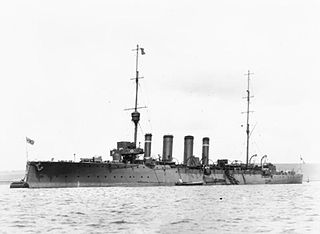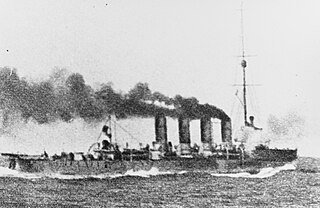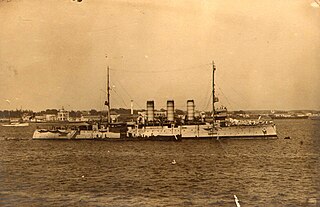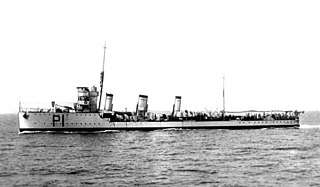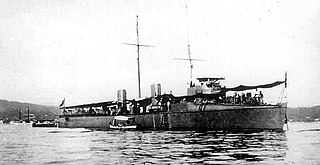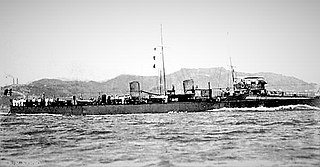World War I
World War I broke out in 1914, and the Italy entered the war on the side of the Allies with its declaration of war on Austria-Hungary on 23 May 1915. At the time, Turbine, under the command of Capitano di corvetta (Corvette Captain) Luigi Bianchi, as well as Aquilone, Borea, Nembo, and their sister ship Espero made up the 5th Destroyer Squadron, based at Taranto. On the afternoon of 23 May 1915, the day Italy declared war, Turbine and Aquilone got underway to patrol in the Adriatic Sea along the Italian coast as far north as Manfredonia. [7] [8]
While Turbine and Aquilone were on patrol, numerous Austro-Hungarian Navy ships left port during the night of 23–24 May 1915 to carry out previously planned bombardments of military targets and coastal cities along Italy's Adriatic coast. At 04:10 on 24 May Aquilone sighted the Austro-Hungarian light cruiser Helgoland, which was bombarding Barletta. Aquilone steered to attack Helgoland, but soon found herself having the worst of the clash as Helgoland interrupted her bombardment and pursued the smaller and less-heavily armed Aquilone. At around 04:30, Turbine arrived on the scene, having identified Helgoland from a range of 9,000 metres (9,800 yd) and closed at high speed to distract Helgoland both from her pursuit of Aquilone and from her bombardment of Barletta. As Aquilone pulled away, Helgoland shifted fire to Turbine and maneuvered to prevent Turbine from interposing herself between Helgoland and the Italian coast. [7] [8]
Outgunned by Helgoland, Turbine took advantage of her greater speed to pull away from the Austro-Hungarian cruiser in an attempt to lure her northward in the direction of the Palagruža (known to the Italians as the Pelagosa) archipelago, where Italian warships that could come to Turbine′s assistance were conducting an amphibious landing. The distance between Turbine and Helgoland increased to over 7,000 metres (7,700 yd), although with the first light of dawn Turbine had to turn toward the east to avoid running aground on the promontory of Gargano. [7] [8]
At 05:30 Turbine sighted the Austro-Huungarian destroyers Csepel and Tátra — larger, more modern, faster, and better armed than Turbine — off her port bow. As the ships passed Vieste on Gargano, the northbound Turbine was substantially surrounded, with Csepel5,400 metres (5,900 yd) off her port quarter, Tátra6,000 metres (6,600 yd) astern, and Helgoland7,000 metres (7,700 yd) abeam to starboard. The Austro-Hungarian ships opened fire at 05:48, damaging Turbine and wounding some members of her crew, including Bianchi. Turbine returned fire and hit Csepel′s mainmast, wounding some of Csepel′s crew. [7] [8]
At 05:50 the ships temporarily ceased fire after sighting another ship to the north-northeast, but they resumed fire at 06:00, when Tátra was about 5,000 metres (5,500 yd) from Turbine and Csepel was 4,600 metres (5,000 yd) away. At 06:10, Turbine′s crew identified the ship sighted at 05:50 as the Austro-Hungarian destroyer Lika, which by then was 6,500 metres (7,100 yd) from Turbine. At 06:30 Lika, which had closed with Turbine to a range of 4,500 metres (4,900 yd), opened fire, quickly scoring two hits, a 66-millimetre (2.6 in) shell which hit Turbine′s forward boiler, causing a violent explosion that damaged her bridge, and shortly after that a 102-millimetre (4 in) shell that hit Turbine′s aft boiler and the starboard side of her wheelhouse. Turbine′s engines shut down, and her inertia carried her only for a short distance before she went dead in the water. [7] [8]
The Austro-Hungarian ships closed to a range of 1,000 metres (1,100 yd), then ceased fire and ordered Turbine′s crew to abandon ship. Turbine′s crew began scuttling procedures, then took to the lifeboats. After destroying secret documents, Bianchi remained aboard the sinking Turbine until the chief helmsman took him onto one of the lifeboats at 06:51. Reduced to a riddled and burning wreck, Turbine sank shortly afterwards. [7] [8]
Turbine′s 53-man crew suffered 10 killed in action. The Austro-Hungarian ships rescued 32 survivors, including Bianchi, and took them as prisoners-of-war. Informed by radio at 06:17 of the clash, the Italian protected cruiser Libia and auxiliary cruiser Città di Siracusa, which were supporting the amphibious landing at the Palagruža archipelago, rushed to the scene and engaged in a brief, indecisive clash with the Austro-Hungarian ships before the Austro-Hungarians withdrew. Libia recovered a sailor who had jumped overboard from an Austro-Huungarian ship to avoid becoming a prisoner, while Città di Siracusa rescued eight men and recovered the bodies of two others. Città di Siracusa transferred the survivors and corpses to Libia. Meanwhile, the Austro-Hungarians transported the Italians they had rescued to Sebenico, where an Italian stoker died of burns he had suffered in Turbine′s sinking. [7] [8]



